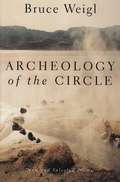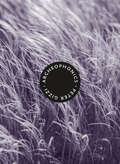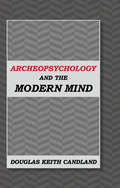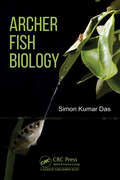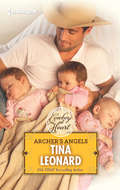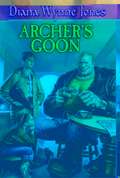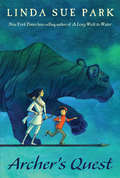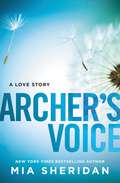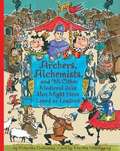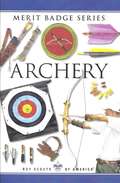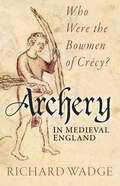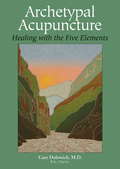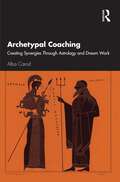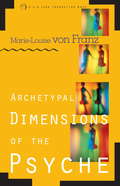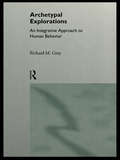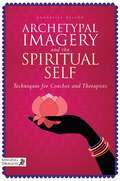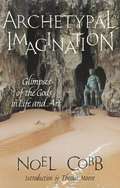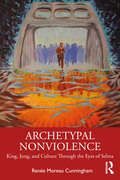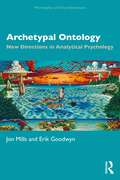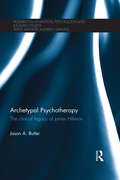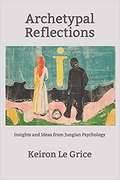- Table View
- List View
Archeology of the Circle: New and Selected Poems
by Bruce WeiglA range of poems from this contemporary poet, including work published as far back as the mid-1970s as well as new creations.
Archeology of the Circle: New and Selected Poems
by Bruce WeiglWith Song of Napalm, Bruce Weigl established himself as a poet of incomparable power and lyric fury, whose work stands as an elegy to the countless lives dramatically altered by war. Archeology of the Circle brings together the major work of one of America’s greatest poets. Collected here for the first time from eight volumes of poetry and spanning two decades, Archeology of the Circle also includes Weigl’s most recent poems, which take a dramatic turn toward a hard-bitten and sensuous lyric. Out of the horror of individual experience, Bruce Weigl has fashioned poetry that offers solace to disillusionment and bears transcendent resonance for all of us. Archeology of the Circle illustrates Bruce Weigl’s remarkable creative achievements and signifies his own personal and spiritual salvation through his writing.
Archeophonics (Wesleyan Poetry Ser.)
by Peter GizziSoulful and intricate lyrics make this Gizzi's strongest book to dateArcheophonics is the first collection of new work from the poet Peter Gizzi in five years. Archeophonics, defined as the archeology of lost sound, is one way of understanding the role and the task of poetry: to recover the buried sounds and shapes of languages in the tradition of the art, and the multitude of private connections that lie undisclosed in one's emotional memory. The book takes seriously the opening epigraph by the late great James Schuyler: "poetry, like music, is not just song." It recognizes that the poem is not a decorative art object but a means of organizing the world, in the words of anthropologist Clifford Geertz, "into transient examples of shaped behavior." Archeophonics is a series of discrete poems that are linked by repeated phrases and words, and its themes and nothing less than joy, outrage, loss, transhistorical thought, and day-to-day life. It is a private book of public and civic concerns.
Archeopsychology and the Modern Mind
by Douglas Keith CandlandCan we access the minds of people of other times? Can we know their psychology: how they understood one another and interpreted human behavior? The author describes examples of how human beings at different times understood their own psychology through the examples of phrenology, how body-types predict temperament, the human need to postulate spirits and alien worlds, attempts to correlate body-type with criminality, and the practice of eugenics. The author argues that these beliefs are not old-fashioned, but still control human ideas about psychology.
Archer Fish Biology
by Simon Kumar DasThis book unveils the secrets of archer fish, covering everything from their morphology to their unique feeding techniques, digestion physiology, and reproductive intricacies. It serves as an essential resource for students, researchers, conservation biologists, and anyone curious about the biology of archer fish, as well as fish biology in general. Readers can immerse themselves in chapters that discuss identification techniques, age, and growth, feeding physiology, and much more. The book highlights the wonders of these remarkable creatures, helping readers gain a deeper understanding of the intricate realm of fish biology.
Archer's Angels
by Tina LeonardShe'd Traveled To Texas For Two Things: A Real Cowboy And A Baby And her e-mail buddy, Archer Jefferson, fit the bill. From his jeans to his hat to his crooked smile, the man was more cowboy than Australian stuntwoman Clove Penmire had bargained for--perfect for helping a friend make one little baby. And although she was known as a plain Jane, Clove refused to let her lack of glamour--or the odd twist of her heart when she saw Archer-interfere with her baby-making mission. She'd be the one to love 'em and leave 'em this time ... until a makeover and one passionate night changed all her plans!
Archer's Angels
by Tina LeonardShe'd come to Texas for two things: a real cowboy and a baby...And her email buddy, Archer Jefferson, fit the bill. From his jeans to his hat to his crooked smile the man was more cowboy than Australian stuntwoman Clove Penmire had bargained for-perfect for helping a friend make one little baby.And Clove refused to let her lack of glamour-or the odd twist of her heart when she saw Archer-interfere with her baby-making mission. She'd be the one to love 'em and leave 'em this time...until a makeover and one night with Archer changed all her plans!
Archer's Goon
by Diana Wynne JonesThe trouble started when Howard Sykes came home from school and found the "goon" sitting in the kitchen. He said he'd been sent by Archer. But who was Archer? It had to do with the 2,000 words that Howard's author father had failed to deliver. It soon became clear not only that Archer wanted those words, but that his wizard siblings, Hathaway, Dillian, Shine, Torquil, Erskine, and Venturus, would also go to any lengths to get them. Although each wizard ruled a section of the town, he or she was a prisoner in it. Each suspected that one of them held the secret behind the words, and that secret was the key to their freedom. Which one of them was it? The Sykes family become pawns in the wizards' fight to win their freedom, wrest control from one another, and fan out to rule the world. Diana Wynne Jones skillfully guides the reader through a riveting, twisty plot, with satisfying surprises at every amazing turn. An exciting science fiction adventure where, happily, nothing is what it first seems to be.
Archer's Quest (Fountas & Pinnell LLI Purple #Level Q)
by Linda ParkIn Dorchester, New York, Kevin is doing his homework when suddenly an arrow comes out of nowhere and pins his baseball cap to the wall. The man who shot the arrow claims he fell off a tiger . . . and wound up in Kevin's room. It's not long before Kevin realizes that the man, who calls himself Chu-mong, or Great Archer, is no ordinary burglar, but a traveler from far away in both space and time.A visit to the local museum confirms that there was a king named Chu-mong in ancient Korea who was legendary for many accomplishments, including exceptional skill with bow and arrow. Kevin knows little about his own Korean heritage, but he understands that unless Archer returns to his people and his throne, history will be changed forever. And he's determined to help Archer go back, no matter what it takes.Award-winning novelist Linda Sue Park has created a funny and suspenseful adventure, incorporating intriguing bits of Korean history and lore, that will captivate even reluctant readers and will add to her audience of devoted fans. Author's note.
Archer's Voice
by Mia SheridanA New York Times, USA Today, and Wall Street Journal bestselling book. Archer's Voice is a full-length, standalone romance.When Bree Prescott arrives in the sleepy, lakeside town of Pelion, Maine, she hopes against hope that this is the place where she will finally find the peace she so desperately seeks. On her first day there, her life collides with Archer Hale, an isolated man who holds a secret agony of his own. A man no one else sees.Archer's Voice is the story of a woman chained to the memory of one horrifying night and the man whose love is the key to her freedom. It is the story of a silent man who lives with an excruciating wound and the woman who helps him find his voice. It is the story of suffering, fate, and the transformative power of love.
Archers, Alchemists, and 98 Other Medieval Jobs You Might Have Loved or Loathed
by Priscilla GallowayA fascinating guide to strange-but-true jobs. If you could go back in time to the Middle Ages, what do you think you would be? A bold knight? A Princess? A Cardinal? In reality, most people did jobs we can barely imagine today.
Archery (Merit Badge Series)
by Boy Scouts of AmericaThis book introduces scouts to the exciting world of archery. It includes safe use, equipment, creation of arrows and other topics.
Archery Fundamentals
by Douglas EnghHead to the range with the skills to hit the bull's-eye. Archery Fundamentals will have you shooting on target in no time. Instruction in all the essentials--from stringing the bow through the anchor to learning aim, grip, and release--will put your technique right on the mark. Sequential instructions and accompanying photographs will guide your execution through every phase of the shot.In addition, you'll find inside tips for choosing and maintaining equipment as well as using accessories to improve your accuracy with both recurve and compound bows. You'll also discover how to use arrow patterns to correct errors. And, if you want to compete, you'll appreciate the recommendations for entering and participating in archery tournaments. Archery Fundamentals is a better, faster way to learn the basics. With this book, you'll have as much fun learning the art of shooting as you'll have hitting your mark consistently.
Archery in Medieval England: Who Were the Bowmen of Crécy?
by Richard WadgeHow was it that ordinary men in medieval England and Wales became such skilled archers that they defeated noble knights in battle after battle? The archer in medieval England became a forerunner of John Bull as a symbol of the spirit of the ordinary Englishman. He had his own popular literature that left us a romantic version of the lives and activities of outlaws and poachers such as Robin Hood.This remarkable development began 150 years after the traumatic events of the Norman Conquest transformed the English way of life, in ways that were almost never to the benefit of the English. This book is the first account of the way ordinary men used bows and arrows in their day-to-day lives, and the way that their skills became recognised by the kings of England as invaluable in warfare.
Archetypal Acupuncture
by Gary DolowichThe Chinese model of the Five Elements (wood, fire, metal, earth, and water) and the Twelve Officials (the organ systems that comprise the map of traditional Chinese medicine) has been applied as a system of medicine for three thousand years to balance chi, the vital force of the body. Archetypal Acupuncture explains to both acupuncturists and the general public how to work with these maps of energy and use them to diagnose physical illness, resolve emotional imbalances, and navigate the stages of life. Dr. Dolowich's goal is to revitalize these traditional teachings for the modern world--and in the process bring East and West together. Through an archetypal approach to Chinese medicine, he shows how we can gain fresh insights into the roots of illness while uncovering a positive vision of wellness and the healing process. The book draws on case histories, spiritual poetry (especially Rilke and Rumi), classic sources such as the I Ching, and examples from contemporary culture in order to bring the elements alive. Individual chapters explore the interface of Eastern and Western medicine, Chinese numerology, spiritual aspects of the elements, archetypal patterns in popular culture, and strategies for cultivating a life in harmony with the rhythms of nature.From the Trade Paperback edition.
Archetypal Coaching: Creating Synergies Through Astrology and Dream Work
by Alba CarodArchetypal Coaching offers a transformative approach to personal growth, blending ancient Greek astrological foundations and dream work with modern coaching techniques, somatic awareness, and Jungian active imagination.Astrological archetypes illuminate the roots of struggles and highlight potential resources, while dreams act as a focused lens, bringing attention to issues that require immediate exploration. The approach explored within this book emphasizes interactive dialogue with archetypes and symbols, using embodied imagination and somatic awareness to guide clients in creating a personal symbol that embodies their inner process and potential, echoing Jung’s concept of the transcendent function. Supported by six in-depth case studies and numerous examples, the author outlines a holistic framework for integrating astrology and dream work into coaching, emphasizing personal growth and treating archetypes as dynamic tools for creativity and self-discovery.This book will appeal to established coaches, counselors, and therapists interested in integrating archetypal work into their practice, as well as students of Jungian psychology, coaching, art therapy, astrology, and related fields.
Archetypal Dimensions of the Psyche
by Marie-Louise von FranzThe chief disciple of C. G. Jung, analyst Marie-Louise von Franz uses her vast knowledge of the world of myths, fairy tales, visions, and dreams to examine expressions of the universal symbol of the Anthropos, or Cosmic Man--a universal archetype that embodies humanity's personal as well as collective identity. She shows that the meaning of life--the realization of our fullest human potential, which Jung called individuation--can only be found through a greater differentiation of consciousness by virtue of archetypes, and that ultimately our future depends on relationships, whether between the sexes or among nations, races, religions, and political factions.
Archetypal Explorations: Towards an Archetypal Sociology
by Richard M. GrayArchetypal Expressions is a fresh approach to one of Jung's best-know and most exciting concepts. Richard M. Gray uses archetypes as the basis for a new means of interpreting the world and lays the foundations of what he terms an "archetypal sociology". Jung's ideas are combined with elements of modern biology and systems theory to explore the basic human experiences of life, which recur through the ages. Revealing the implicitly cross-cultural and interdisciplinary nature of Jungian Psychology, Archetypal Explorations represents a significant contribution to the literature of archetypes and integrative approaches to human behaviour.
Archetypal Grief: Slavery’s Legacy of Intergenerational Child Loss
by Fanny BrewsterArchetypal Grief: Slavery’s Legacy of Intergenerational Child Loss is a powerful exploration of the intergenerational psychological effects of child loss as experienced by women held in slavery in the Americas and of its ongoing effects in contemporary society. It presents the concept of archetypal grief in African American women: cultural trauma so deeply wounding that it spans generations. Calling on Jungian psychology as well as neuroscience and attachment theory, Fanny Brewster explores the psychological lives of enslaved women using their own narratives and those of their descendants, and discusses the stories of mothering slaves with reference to their physical and emotional experiences. The broader context of slavery and the conditions leading to the development of archetypal grief are examined, with topics including the visibility/invisibility of the African female body, the archetype of the mother, stereotypes about black women, and the significance of rites of passage. The discussion is placed in the context of contemporary America and the economic, educational, spiritual and political legacy of slavery. Archetypal Grief will be an important work for academics and students of Jungian and post-Jungian studies, archetypal and depth psychology, archetypal studies, feminine psychology, women’s studies, the history of slavery, African American history, African diaspora studies and sociology. It will also be of interest to analytical psychologists and Jungian psychotherapists in practice and in training.
Archetypal Imagery and the Spiritual Self: Techniques for Coaches and Therapists
by Annabelle NelsonCombining psychology and spirituality, this practical book considers archetypes from Asian, Middle Eastern and European myths and explains how they can be used in therapeutic practice to help clients achieve personal or clinical goals. This innovative model of archetype imagination is a powerful tool for coaches and therapists. It involves visualizing an archetype, which teaches the mind to focus, relaxes the ego, and opens the unconscious. This makes space for spiritual insights and allows the mind to let go of distracting sensations and emotions. Combining foundational psychological theories, brain physiology, and Hindu philosophy with the author's visionary experiences, this book explains how to use this technique in clinical practice. It also includes case studies, engaging images, practical exercises, and quizzes for use with clients. Spiritual seekers will find the book's insights a great complement to their practice. This book will help counsellors, coaches, psychologists, psychotherapists, arts therapists, and other therapeutic practitioners to use archetype imagination techniques to guide their clients to emotional health and spiritual awareness.
Archetypal Imagination: Glimpses of the Gods in Life and Art
by Noel CobbCobb teaches us to look at the world as a record of the soul's struggles to awaken and as the soul's poetry. <P><P>From this perspective, the real basis of the mind is poetic. Beauty, love, and creativity are as much instincts of the soul as sexuality or hunger. <P><P>Cobb shows us how artists and mystics can teach us the meaning of love, death, and beauty, if only we can awaken to their creations.
Archetypal Nonviolence: Jung, King, and Culture Through the Eyes of Selma
by Renée Moreau CunninghamRenée Moreau Cunningham’s unique study utilizes the psychology of C. G. Jung and the spiritual teachings of Mahatma Gandhi and Martin Luther King, Jr. to explore how nonviolence works psychologically as a form of spiritual warfare, confronting and transmuting aggression. Archetypal Nonviolence uses King’s iconic march from Selma to Montgomery, a demonstration which helped introduce America to nonviolent philosophy on a mass scale, as a metaphor for psychological and spiritual activism on an individual and collective level. Cunningham’s work explores the core wound of racism in America on both a collective and a personal level, investigating how we hide from our own potential for evil and how the divide within ourselves can be bridged. The book demonstrates that the alchemical transmutation of aggression through a nonviolent ethos, as shown in the Selma marches, is important to understand as a beginning to something greater within the paradox of human violence and its bedfellow, nonviolence. Archetypal Nonviolence explores how we can truly transform hatred by understanding how it operates within. It will be of great interest to Jungian analysts and analytical psychologists in practice and in training, and to academics and students of Jungian and post-Jungian studies, American history, race and racism, and nonviolent movements.
Archetypal Ontology: New Directions in Analytical Psychology (Philosophy and Psychoanalysis)
by Jon Mills Erik GoodwynIn this novel re-examination of the archetype construct, philosopher Jon Mills and psychiatrist Erik Goodwyn engage in spirited dialogue on the origins, nature, and scope of what archetypes actually constitute, their relation to the greater questions of psyche and worldhood, and their relevance for Jungian studies and analytical psychology today.Arguably the most definitive feature of Jung’s metapsychology is his theory of archetypes. It is the fulcrum on which his analytical depth psychology rests. With recent trends in post-Jungian and neo-Jungian perspectives that have embraced developmental, relational, social justice, and postmodern paradigms, classical archetype theory has largely become a drowning genre. Despite the archetypal school of James Hillman and his contemporaries, and the archetype debates that captured our attention over two decades ago, contemporary Jungians are preoccupied with the lived reality of the existential subject and the personal unconscious over the collective transpersonal forces derived from archaic ontology. Archetypal Ontology will be of interest to psychoanalysts, philosophers, transpersonal psychologists, cultural theorists, anthropologists, religious scholars, and scholars in many disciplines in the arts and humanities, analytical psychology, and post-Jungian studies.
Archetypal Psychotherapy: The clinical legacy of James Hillman (Research in Analytical Psychology and Jungian Studies)
by Jason A. ButlerArchetypal psychology is a post-Jungian mode of theory and practice initiated primarily through the prolific work of James Hillman. Hillman’s writing carries a far-reaching collection of evocative ideas with a wealth of vital implications for the field of clinical psychology. With the focus on replacing the dominant fantasy of a scientific psychology with psychology as logos of soul, archetypal psychology has shifted the focus of therapy away from cure of the symptom toward vivification and expression of the mythopoetic imagination. This book provides the reader with an overview of the primary themes taken up by archetypal psychology, as differentiated from both classical Jungian analysis and Freudian derivatives of psychoanalysis. Throughout the text, Jason Butler gathers the disparate pieces of archetypal method and weaves them together with examples of dreams, fantasy images and clinical vignettes in order to depict the particular style taken up by archetypal psychotherapy—a therapeutic approach that fosters an expansion of psychological practice beyond mere ego-adaptation and coping, providing a royal road to a life and livelihood of archetypal significance. Archetypal Psychotherapy: The clinical legacy of James Hillman will be of interest to researchers and academics in the fields of Jungian and archetypal psychology looking for a new perspective, as well as practising psychotherapists.
Archetypal Reflections: Insights And Ideas From Jungian Psychology
by Keiron Le GriceIn this book, Keiron Le Grice shares his expertise in depth psychology and its central preoccupation: the workings of the unconscious mind. Adapted from his teaching in the Jungian and Archetypal Studies specialization at Pacifica Graduate Institute, California, Archetypal Reflections provides concise paragraph-length analyses and explanations of a wide range of topics, focusing on the work of C. G. Jung and other influential figures such as Nietzsche, Freud, Campbell, and Hillman. Skillfully illuminating Jung's theories of archetypes, individuation, the Self, and synchronicity, Le Grice also explores a number of other fascinating topics such as the role of the unconscious and myth in modern culture, the evolution of consciousness and civilization, the quest for spiritual meaning in a secular age, and the intersection of depth psychology and the new sciences. The primary concern throughout is the capacity of depth psychology to inform and transform our worldview, addressing the question of how we might find greater meaning and spiritual fulfillment in life. Le Grice shows how Jungian ideas can provide a source of deep wisdom to inform the inner journey and help us to better understand our place in the larger scheme of things.
